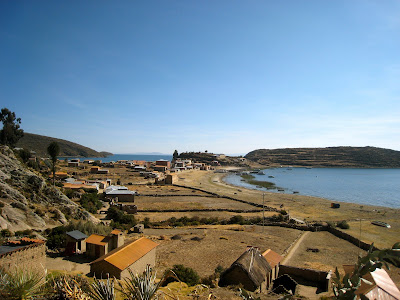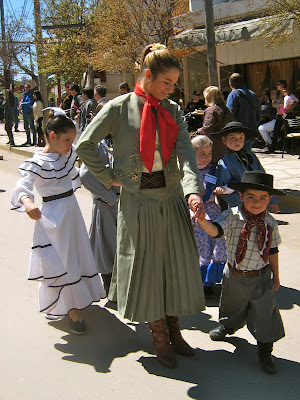Bolivia: August 14-23, 2010Part 1: La Paz & Isla del SolMy friend Agata is one of the first people I talked to when I was thinking about moving to Argentina. I remember pacing on the phone outside of my office listening to her words of encouragement and promise to visit after her bar exam. About six months later, we were planning our trip to Bolivia! Agata and I logged hours of online research and Skype conversations planning each detail of the adventure. We mapped out how long we were to stay in each place and how long it would take us to get to the next. We had a solid plan that would allow us to see and experience as much of Bolivia as we possibly could in 9 days!
Well… you know what they say about the best laid plans… a combination of current events and accidents changed our course significantly, but we all adapted well and embraced each turn of events. I’m going to try to break this trip up into a few entries due to the length and significance of the trip. Keep in mind as you’re reading that I’m writing for my family and friends to follow my adventures, but also to serve as a reminder to myself when I read this blog years from now.
This trip to Bolivia was perfectly timed for a few reasons: I needed to renew my 90-day Argentina visitor’s visa, I was feeling an itch to get out of Buenos Aires, I was craving something/one familiar from home and it was a distraction from the fact that I had to say goodbye to Damien. Damien was returning to France the same day that Kelly and I left for Bolivia. He has become a close friend over the past few months and saying goodbye to him was very difficult – though I know we will find each other again one of these days… somewhere on the map.
Kelly and I spent our first night in Bolivia playing cards and sharing beers with our hostel-mates in La Paz. Are you all starting to pick up on a recurring theme here? I experienced altitude sickness for the first time on Sunday morning when we woke up to catch the bus to Copacabana. This was our first shift in plans. Both of us were unable to get out of bed because we were nauseous and lightheaded. I could barely walk to the bathroom, so I certainly couldn’t put on my 11.5kg backpack (just over 25 lbs)! Yes, I know how heavy my backpack was because they weighed it at the airport and I was cursing that number for the next 9 days.
We wandered the streets of La Paz for a few hours before boarding the three-hour bus to Copacabana. We watched part of a service in a church, paid our respects to those no longer with us in a beautiful cemetery and took pictures of Bolivian women dressed in traditional garb carrying babies in make-shift swaddles and selling vegetables on the side of the road.
 Vegetables on the streets of La Paz
Vegetables on the streets of La PazI didn’t think Copacabana was anything to write home about, so I won’t waste blog space saying more than this: the streets were dirty, the hostel was dull and our food was bland, but the sunset over Lake Titicaca was beautiful.
 Copacabana
CopacabanaMonday (Aug. 16) is when the trip really began for me. We piled onto a small, rickety boat and began the two-hour voyage across Lake Titicaca to Isla del Sol. I sat on the top of the boat listening to fellow travelers and reflecting on my own knowledge and experiences. As I listened to Aiden recount the history of fighting in his home of Northern Ireland, I realized how little I know about the world and even my own country’s history.
How many places have I seen without learning more than what it looks like through the lens of my camera? I suppose that’s one of the hard parts of traveling – there is always someone who has been somewhere you haven’t. Meeting these people only feeds my addiction to travel and my desire to be more culturally knowledgeable, but that’s a whole separate blog entry.
Our first mission when we got off the boat on the south side of the island was to climb to our hostel. I stood there at the foot of what had to be hundreds of steps, strapped myself into my backpack, tightened my new hiking boots and reminded myself to take advantage of each moment. I was sitting on the side of the walkway about forty steps later struggling to catch my breath (I blame the altitude) and cursing my habit of over packing! Kelly and I laughed at one point when we thought of how proud my dad would be of us “load walking” up a mountain in Bolivia.
 looking up the stairs to the top of the mountain
looking up the stairs to the top of the mountain side view of the steep mountain we had to climb
side view of the steep mountain we had to climbAfter we ditched our backpacks in the hostel (which we didn’t end up staying in), Kelly and I walked across the island to Temple del Sol. The stone establishment known as Pilko Kaina (meaning “resting house” in the Incan language) was interesting, but I was naturally more attracted to the water. I sat on a dock stretching into Lake Titicaca wondering how I got to be so blessed in life!
 native woman looking out over Lake Titicaca - between the south village and resting house
native woman looking out over Lake Titicaca - between the south village and resting house Lake Titicaca
Lake Titicaca
I was a little nervous about meeting Kevin and Agata on the Isla del Sol because we didn’t have phones or an Internet connection, and I wasn’t sure if they got my last e-mail with hostel information while they were in Peru. Ever wonder how people function without cell phones and Internet? Well approximately 800 families on Isla del Sol do it every day. Luckily there is only one set of stairs ascending the mountain, and we met Agata and Kevin as they were reaching the top. Our goal was to meet their boat to be sure they got off on the south side (the boats then continue to the north side) but we didn’t notice the time change and started walking down an hour late. I was immediately thankful they knew to get off – and even more thankful I didn’t have to walk up the stairs again! We walked around for a while with the group finally together then resorted to playing cards in the restaurant by our (new, cheaper) hostel.
We woke up before sunrise on Tuesday (Aug. 17) morning to hike to the north side of Isla del Sol. We were told the hike would take a couple hours, but to give you an idea of how little we knew about this island: Agata thought there would be bars and ATMs on the other side.
 Kevin & Agata leading the way to the north of Isla del Sol
Kevin & Agata leading the way to the north of Isla del Sol
I’m inclined to describe this hike as one of the most physically difficult things I’ve endured, but I know that’s a little over dramatic. I think it just felt more difficult because I wasn’t prepared for the strenuous hike ahead of us. We set out on a 6 km path that would take us around the island but somehow found ourselves on the 16 km path after we missed an unmarked fork in the road (Kevin said he noticed it and I’m still bitter that he didn’t point it out). The sun was strong, our water was sparse and the altitude was just less than 4,000 meters.
I began to view each stint of level ground as sacred – a chance to catch my breath and remove my eyes from the rocks I struggled to pick my feet up over so I could shift them to the beautiful landscape surrounding me. I could feel the sun beating down on me as I prayed for shady relief from the heat and my burning flesh. I tried to remind myself to simply put one foot in front of the other as I felt the weight of my boots dragging me down with each step.
 looking/feeling rough but loving the view
looking/feeling rough but loving the viewWe didn’t find bars or ATMs on the north side. In fact, we didn’t even find open restaurants or a place to buy drinking water. We walked along the beaches and through the houses of the north side taking pictures, taking breaks and giving Kevin hell. “Kevin, I just realized we only have enough Bolivianos to get three of us off this island,” was my exact response when he informed us that we should climb over the mountain we were walking around and pick up the trail on the other side.
 took a shortcut over the mountain
took a shortcut over the mountain
Kevin (look close to the water) and Agata leading the way down the side of the mountain to meet the trail again still looking for the trail - which Kevin claimed he could see from the top of the mountain
still looking for the trail - which Kevin claimed he could see from the top of the mountain north side of Isla del Sol
north side of Isla del SolI could barely eat or drink when we got back to the hostel. I just wanted to sit and wallow in my sunburned, exhausted misery for the few minutes we had before putting on my 11.5kg backpack and walking down the mountain to catch the 2-hour boat ride back to Copacabana. But at the end of the day, it suddenly all seemed worth it for the pictures and sense of accomplishment I had after the hike.
 me & Megan
me & Megan me & Flor
me & Flor me & Kelly
me & Kelly me & random old German man?
me & random old German man? Ukrainian dancers - best in the show
Ukrainian dancers - best in the show (obviously we had to take a picture with them)
(obviously we had to take a picture with them)













































